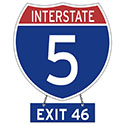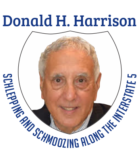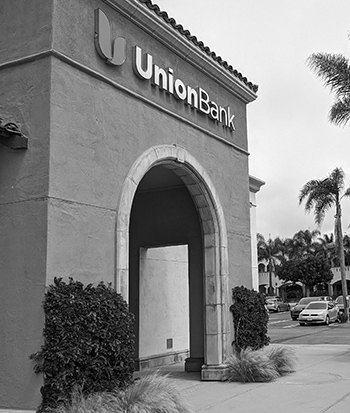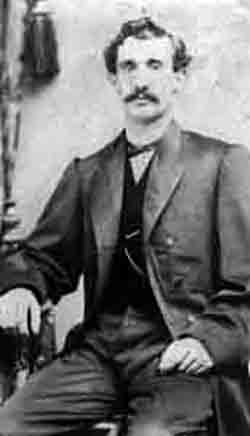 Editor’s Note: This is the 18th chapter in Volume 3 of Publisher and Editor Donald H. Harrison’s 2022 trilogy, “Schlepping and Schmoozing Along the Interstate 5.” All three books as well as others written by Harrison may be purchased from Amazon.com.
Editor’s Note: This is the 18th chapter in Volume 3 of Publisher and Editor Donald H. Harrison’s 2022 trilogy, “Schlepping and Schmoozing Along the Interstate 5.” All three books as well as others written by Harrison may be purchased from Amazon.com.
Schlepping and Schmoozing Along the Interstate 5, Volume 3, Exit 46 (Poinsettia Lane): Union Bank
From northbound Interstate 5, take the Poinsettia Lane exit and turn left. Take another left turn at Avenida Encinitas. Bank is located at 7188 Avenida Encinas, Suite 120, Carlsbad.


CARLSBAD, California – On September 21, 2021, U.S. Bancorp announced its $8 billion purchase of the 305 branches of Union Bank, including this one in Carlsbad. Owned by the Mitsubishi UJF Financial Group of Japan, the Union Bank had grown into an institution with $90 billion in deposits, $58 billion in loans, approximately 1 million consumer customers, and 190,000 small-business customers primarily in California, Oregon, and Washington. It also operated commercial branches in Georgia, Illinois, New York, and Texas.
The bank had come a long way since its founding by Kaspare Cohn, a leading citizen of Los Angeles who lived in the late 19th century and early 20th century. A Prussian-born entrepreneur with wide-ranging business investments, Cohn had been a valued friend and adviser to Basque shepherds whose sheep used to range over Southern California. In 1882, his K. Cohn and Company purchased and shipped their wool throughout the United States. In 1896, the successor Pacific Wool Company added the service of washing and scouring the wool before sending it on to manufacturers. According to a 1991 article by the late Rabbi William M. Kramer in the quarterly publication Western States Jewish History, Pacific Wool projected sales of 4 million pounds of wool per year.
Sheepherders travel with their flocks. Rather than keep their money with them, out in the open, they so trusted Cohn that they asked him to keep their money for him in his safe, allowing them to withdraw it according to need. Agreeing, Cohn, in effect, became a private banker. As he sometimes held as much as $300,000 is sheepherders’ funds at a time. California law required him to form a banking corporation. So, in 1914, along with his sons-in-law Ben Meyer and Milton Getz – married respectively to Cohn’s daughters Rae and Estelle – he filed articles of incorporation for the Kaspare Cohn Commercial and Savings Bank. Two years later, Cohn died, and two years after that on June 24, 1918, the bank’s name was changed to Union Bank Trust Company on the motion of Meyer, who had succeeded Cohn as president, and Getz, who served as vice president. The bank was then headquartered at 740 South Broadway in Los Angeles.

Cohn was just 20 years old when he arrived in Los Angeles in 1859 from Loebau, Prussia, to work for his uncle Harris Newmark. His introduction to the primitive banking system in 19th century California came when his uncle had him sleep on the floor of the family grocery store as a way of safeguarding the finances of Los Angeles County. With no banks in Los Angeles at the time, county treasurer Maurice Kremer – a Newmark cousin – arranged to keep between $40,000 and $50,000 in county funds in the grocery store’s safe. By visibly sleeping on the floor, young Cohn discouraged any would-be burglars from breaking in and attempting to open the safe.
A year later, Newmark sent his nephew to his Fort Tejon branch store, which then serviced an Army detachment in the area know popularly as “the Grapevine” between Los Angeles and the San Joaquin Valley. He learned the retailer’s trade there for four years before striking out briefly on his own, opening a crockery store in Red Bluff, California. When the U.S. Civil War ended, Cohn returned to Los Angeles where, along with his brother Samuel, he entered into a partnership with Newmark as a wholesaler of groceries, hardware, wagon materials, paints, oils, glass doors, windows, and equipment for farming and mining. The partnership also purchased wools and hides from local ranchers.
Cohn’s brother Samuel left the business, which Newmark and Cohn continued until 1896, when they divided it. Newmark focused on buying cattle hides, while Cohn concentrated on purchasing wool.
In 1899, along with William Mulholland, Newmark and Cohn developed the City of Montebello from 800 acres of land they had acquired in 1885. Cohn also invested in the 8,000-acre Santa Anita Ranch, from which purchaser Lucky Baldwin subsequently developed the Los Angele County Arboretum (once the locale of Fantasy Island, a television series starring Ricardo Montalbán and Herve Villechaize) and the Santa Anita racetrack.
As his business successes grew to the point that he became a multimillionaire, so did Cohn’s philanthropies. Perhaps the best known of these was the Kaspare Cohn Hospital that he financed and dedicated in 1902. Originally, it was converted from a two-story house. As needs grew, the hospital was relocated in 1909 and rededicated in 1910 on Whittier Boulevard, then known as Stephenson Avenue. In 1913, from his personal funds, Cohn wrote a check for $5,300 to pay off the hospital’s debts. He died three years later in 1916. As in the case of the Kaspare Cohn Commercial and Savings Bank, his family members requested in 1929 when the hospital moved to Fountain Avenue that its name be changed to Cedars of Lebanon Hospital. Today, following a fourth move and merger with Sinai Hospital, Cohn’s little hospital has evolved into the world-renowned Cedars-Sinai Medical Center.
Cohn served from 1900 through 1910 as president of Temple B’nai B’rith of Los Angeles, which evolved after several moves into the Wilshire Boulevard Temple, a well-known Reform congregation. Girls at the temple created the Kaspare Cohn Club in 1902 with a goal of raising funds for the Kaspare Cohn Hospital. Among Cohn’s favorite aspects of the temple was its school, for which he created the Kaspare Cohn Gold Medal awarded to the best pupil of each year. At his ranch, with grounds covered with fruit trees and flowers, Cohn grew the lulavim (palm fronds) and etrogim (citrons) used in ceremonies celebrating the holiday of Sukkot.
Home-grown flowers were a special joy of Cohn’s. Rabbi William Kramer reported that each day Cohn would gather three bouquets. One went to the conductor of the streetcar that carried him to his office, another went to the motorman, and the third was displayed on his desk at the office.
In 1902, Cohn advanced the money for the Los Angeles Jewish community to purchase in Boyle Heights a second communal cemetery that was named Home of Peace. He also arranged, at considerable expense to himself, for the Los Angeles Railway Company to extend its streetcar line to the cemetery. He and his wife Hulda, whom he married on July 17, 1872, were prominent supporters of the Hebrew Benevolent Society and the Ladies Hebrew Benevolent Society, which came to the aid of the destitute and also provided burials.
Another Cohn-sponsored charity was the Southern California Jewish Orphans Home located in the Sarah and Harris Newmark Park in Montebello. He also was a lead contributor in 1915 to the Hebrew Sheltering Association of Los Angeles, which became that city’s Jewish Home for the Aging.
The City of Los Angeles also benefitted from his services as a member of the Board of Freeholders, which successfully offered modernizing revisions to the Los Angeles City Charter.
His son-in-law Ben Meyer followed in Cohn’s charitable footsteps, serving as president of the Kaspare Cohn Commercial and Savings Bank, as a supporter of the Jewish “Yishuv” in Palestine and president of the Federation of Jewish Charities, among other honors. As president of the hospital, he reportedly visited the facility every morning, greeting patients and staff alike. In a website article discussing its history, Union Bank reported that “while attending a ballet one evening at the Hollywood Bowl, Meyer discovered that the performance was in danger of being canceled since the stagehands had not been paid their wages. Meyer went backstage, presented the stagehands with a personal check for what they were owed, and the show was performed.”
Union bank survived the Depression and grew after World War II. Herman Hahn, who had worked for the bank for 20 years, succeeded Meyer in 1950 but died four years later, causing Meyer to come out of retirement temporarily. In 1957, Henry Volk, a veteran of the insurance industry, became the fourth president. Over the next decades, the bank acquired Occidental Bank, which had operated in the San Fernando Valley. In 1967, Union Bancorp, a holding company, was formed, changing its name two years later to Unionamerica. This facilitated acquisition of diversified financial services, including the purchase of Western Mortgage Company. However, new federal law required Unionamerica to divest some of its holdings and change its name back to Union Bancorp. Expansion continued with acquisition of banks in Oakland, San Francisco, Palo Alto, and Long Beach. Union Bancorp opened offices in London, Rio de Janeiro, and Tokyo.
In 1988, the Bank of Tokyo purchased Union Bank. The Bank of Tokyo and Mitsubishi Bank Ltd. Merged in 1995, creating a bank with assets of $820 billion. The two Japanese concerns decided to merge their subsidiaries, Union Bank and the Bank of California, renaming the merged company as Union Bank of California.
Union Bank remained in that status until its purchase by US Bancorp was announced in 2021.
In Western States Jewish History articles about Cohn, Rabbi Kramer described the businessman and philanthropist as “a man who helped make Southern California.” Cohn had helped to create a world-class bank and a leading hospital, among his many other works.
*
Donald H. Harrison is publisher and editor of San Diego Jewish World. He may be contacted via sdheritage@cox.net